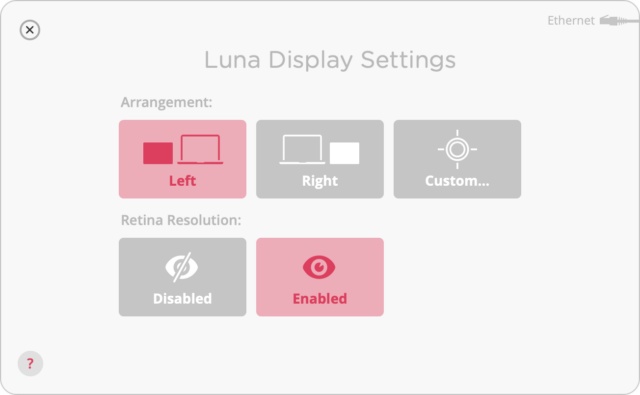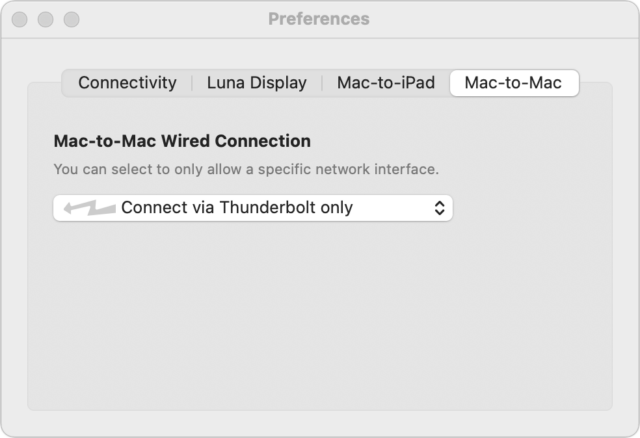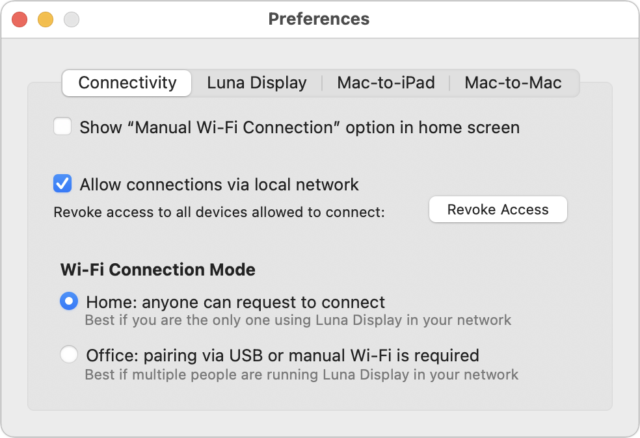Luna Display Turns a 27-inch iMac into a 5K Display
The recent disappearance of the 27-inch iMac with 5K Retina display from Apple’s product line has thrown a spotlight on the core design tradeoff with an all-in-one Mac: you can’t separate the Mac from the monitor when it comes time to upgrade (see “Which Mac Will Replace the 27-iMac for You?,” 12 March 2022). But what if you could somehow connect the old Mac in such a way as to make it look like a display to a new Mac? That’s the concept behind Astropad’s $134.95 Luna Display. When we first covered the product in “AstroHQ’s Luna Display Dongle Turns a Mac into a Second Display” (20 November 2019), Julio Ojeda-Zapata concluded:
Though not yet fully baked, especially on the DisplayPort end, Luna hardware and its related software are a godsend for those with extra Macs ready to be repurposed as second displays.
Since Astropad’s initial release of the Mac-to-Mac mode, the company has radically improved Luna Display. Most notably, starting with version 5.1, Luna Display has seemingly achieved the holy grail of dongle-based display—support of the 27-inch iMac at full 5K Retina resolution. Alison Sheridan of Podfeet recently wrote about Luna Display in detail, finding that it works well for her setup, and after talking to her about it, I summoned the energy to move my 27-inch Thunderbolt Display to the floor and replace it with one of my extra 2014 27-inch iMacs.
To make a long story short, Luna Display does turn my older 27-inch iMac into a secondary 5K Retina display for my 2020 27-inch iMac—with that wonderfully crisp Retina text—but it comes with quite a few tradeoffs. I don’t know if I could live with them because Luna Display exacerbates a problem related to my particular 2020 27-inch iMac that causes multiple kernel panics per day. That was sufficiently troubling that I switched back to my Thunderbolt Display as soon as I finished writing this article. More about the kernel panics later.
Luna Display Tradeoffs
Refer to Julio’s and Allison’s articles for details about the Luna Display setup. In essence, you:
- Make sure that your primary Mac and secondary Mac are on the same network
- Download and run the Luna Secondary app on the secondary Mac
- Plug the Luna Display USB-C dongle into your primary Mac
- Download and run the main Luna Display app on your primary Mac
Since I understood the concept, I went about installation fairly haphazardly, but it worked instantly out of the box. I moved all the windows I like on my secondary screen over to it and went to work. That’s when I started to run into all the tradeoffs of using what is essentially an impressive hardware hack as an everyday monitor.
Tradeoff #1: Interface Performance Is Good but not Great
As soon as I started using my secondary iMac as a display, I noticed issues with three interface interactions:
- Pointer: When I scrubbed the pointer in tight circles, it felt slightly jittery. On my primary iMac, quick pointer movements are smooth and feel tightly connected to physical actions, whereas on the secondary display, the pointer always went where I wanted and did what it should, but I sometimes got the sense that it was disappearing from one spot and reappearing in the next, rather than moving smoothly from one to the other.
- Windows: Similarly, when I dragged an entire window, the text in the window would get fuzzy while it was moving and then come back into focus a split second after I stopped dragging.
- Scrolling: My Contour Designs RollerMouse Pro has a scroll wheel that I use heavily for scrolling through long Web pages and the like. Quick scrolling caused text to lose focus slightly while moving and then regain it when the motion stopped.
None of these problems were deal-breakers, and forcing Luna Display to use Thunderbolt to connect (in Luna Display > Preferences > Mac-to-Mac) reduced their severity. If you were using the 40 Gbps Thunderbolt 3—my 2014 27-inch iMac supports only the 20 Gbps Thunderbolt 2—the extra speed might eliminate all the interface hiccups. Regardless, I suspect I would get used to the slight performance issues over time if I were to use Luna Display for longer.
Tradeoff #2: It Occupies Two Thunderbolt Ports
Switching Luna Display’s connection method from Wi-Fi to Thunderbolt revealed another problem. My 2020 27-inch iMac has only two Thunderbolt ports. The USB-C Luna Display dongle occupies one of them (Astropad strongly recommends plugging the Luna Display dongle directly into your Mac), and the Thunderbolt cable (with a Thunderbolt 3 to Thunderbolt 2 adapter) to the secondary Mac took up the other, forcing me to disconnect one of my backup drives that normally connects via USB-C.
As with the performance problems, this is far from a deal-breaker. I could always settle for a Wi-Fi or Ethernet connection to the secondary Mac because both worked acceptably, if not quite at the level of Thunderbolt. That’s not surprising given the two Macs’ shared 802.11ac Wi-Fi 5 connections are probably a bit slower than their gigabit Ethernet connections, and neither compares to the 20 Gbps Thunderbolt 2 in the 2014 27-inch iMac.
Alternatively, if performance was paramount, I could potentially use a Thunderbolt hub to provide additional ports. That would add to the cost but offer other benefits as well.
Tradeoff 3#: Video Is Fuzzy and Jerky
I don’t watch much video, but when I do, it’s almost always a quick YouTube video playing in Brave, which lives on my secondary screen. As you might expect, the performance issues that manifest themselves in small ways when working with interface elements become far more noticeable with a video, and even more so when I expanded the video to full screen.
To be fair, the video is entirely watchable, just pixelated. And if you’re watching something with relatively little movement—YouTube likes to show me Saturday Night Live skits—it’s not a major problem. However, the track race videos that I intentionally watch are painfully blurry.
Of course, we’re talking about a secondary display here too. Nothing prevents you from playing videos on your primary display, where they won’t suffer from any screen-related quality issues.
Tradeoff #4: Apple Watch Unlocking No Longer Works
I didn’t anticipate this annoyance. Apparently, when the screen-sharing technology underneath Luna Display is active, Apple won’t allow the Apple Watch to unlock the Mac. I’m not sure what the security concern here is, but I suppose it’s better to be safe than sorry. There is no workaround—you simply lose Apple Watch unlocking, which is a shame.
On a related note, Luna Display offers two Wi-Fi connection modes: Home and Office. If you’re the only person using Luna Display, the Home mode makes it so any Mac on the Wi-Fi network can request to connect to the secondary Mac. That would result in confusion in an environment where multiple people are using Luna Display, so Office mode requires pairing via USB or a manual Wi-Fi connection on the initial setup.
Tradeoff #5: Restarts Require Login App Window Rearranging
When you attach a normal secondary display to a Mac, it’s present at startup, so apps whose windows were on the secondary display can put them back there when you restart. However, because Luna Display is an app and because it takes a few minutes to connect to the secondary display, all apps that launch at login position their windows on the primary Mac’s screen.
Perhaps I’m unusual in this regard, but I always launch all my core apps at login, and when I’m using my Thunderbolt Display, they all appear in their appointed positions on either the primary or secondary screen. When I switched to Luna Display, I had to reposition those apps that are normally on the secondary screen on every restart.
Again, this problem has multiple workarounds. I could avoid launching anything other than Luna Display at login, and apps that I manually launched after it would be able to place their windows on the secondary screen. Alternatively, multiple utilities can reposition windows according to a pre-defined layout.
I didn’t get as far as exploring either of those workarounds because of the final problem: constant kernel panics. I’m not laying this at the feet of Luna Display because it’s clearly a problem with my hardware setup, but for my particular situation, it rendered Luna Display unusable.
About Those Kernel Panics
Thirteen months after I purchased the 2020 27-iMac, it began experiencing kernel panics, mostly during sleep. The kernel panics from September 2021 mostly started with this line:
panic(cpu 4 caller 0xffffff80229fea25): userspace watchdog timeout: no successful checkins from com.apple.WindowServer in 120 seconds
Searching on that text turned up a variety of discussions pointing the finger at NVRAM and SMC, at attached monitors, and more. The problem seems quite common, judging from the 45-screen discussion on MacRumors that continues to this day, across multiple versions of macOS. I’ve tried lots of different things, and what has worked—for months at a time—was some combination of disconnecting all devices, resetting NVRAM and SMC, and slowly adding things back. I can’t say what part of the process helped, but even when it has helped, kernel panics eventually return, usually when I change something associated with my Thunderbolt Display. And I’ve tried two different displays, and I swapped cables and adapters with Tonya, whose 27-inch iMac has never experienced such issues.
Some other kernel panics during this time, and all those since I began testing Luna Display this month, start differently. In this one, the Core: 0 and IA32 lines repeat with various changes four to six times:
CPU Machine Check Architecture Error Dump (CPU: UNKNOWN, CPUID: 0x80000009000A0655)
Core: 0
IA32_MC0_STATUS=0xB200000000000406
IA32_MC0_CTL=0x0
My most recent kernel panic came after switching back to the Thunderbolt Display, but it also happened back in September when I first played with the Luna Display. It started with:
panic(cpu 0 caller 0xfffffff012386fa0): x86 CPU CATERR detected
Debugger message: panic
I might be able to get Apple Support to help somehow, but given that I can’t reproduce the problem at will, and it often goes away for months at a time, I haven’t been able to generate the energy to open a ticket. Had the iMac still been under warranty when all this started, I would have been more enthused.
Perhaps surprisingly, these kernel panics aren’t much of an interruption, partly because they almost always happen during sleep. When I’m using the Thunderbolt Display, I wake up the Mac and log in, after which it launches all the apps that were open when the panic occurred. Within a minute or two, I can get back to work, right where I left off. All my apps either auto-save or are cloud-based, though I have to be careful to click the Restore button in Brave to get my numerous tabs back. I don’t think I’ve ever lost any work to the crashes.
So if there’s one kernel panic every month or two, it’s hard to justify putting that much effort into fixing it. I recorded five kernel panics in six days back in September, after which I had one in late January, one in early March, and then two or three per day while I was testing the Luna Display. It was easiest to go back to the Thunderbolt Display, and although that reduced the frequency of the panics, I’ve still had three since reverting.
But don’t let my problems prevent you from trying Luna Display, as long as you go into it aware of its tradeoffs.



Very inyeresting read, @ace. I found your report on experienced performance and conclusions re: potential pitfalls particularly interesting.
I’m always surprised these solutions work as well as they do – even when reviewers justifiably criticize their shortcomings.
Just consider the raw required bandwidth of a 5K display, even at only 30 Hz refresh and using just 8-bit color.
2560*1440*4 pixels * 3 colors/pixel * 8 bits/color * 30 Hz = 10.6 Gbps
(and in reality it’s even 3% more)
And that’s at just 30 Hz! In order to get this image data across a wifi network, even if it’s pretty good wifi, I would expect compression has to get the data rate down by almost 2 orders of magnitude. Even wired Gigabit between only these two clients would still require compression by at least one order of magnitude. Now of course often times (maybe even most times) only few of those almost 15 megapixels need to be updated, but the fact that you can even move a window around and get reasonable refresh and image quality (let alone watch TV) is an indicator that indeed such a dongle solution can compress and push data incredibly well over the network. To me that’s quite an impressive feat in itself. Even if for some workflows/tasks that’s definitely still not good enough.
Oh yeah, what Luna Display is accomplishing is total magic, even with those tradeoffs. I have to imagine that it’s really hard too, since they would have wanted to ship with 5K support if they could have, but it took two years to get it working well enough.
I really, really hope that Astropad can somehow tweak this so I could use a 27"iMac as the PRIMARY display for a Mac Studio


Tempting. Two things keep me from instantly buying one:
I like my secondary monitor to be vertical. I’m not sure I can rig something up to mount my iMac sideways or if Luna Display supports that.
My 2015 Intel iMac is going to eat up a lot more energy than my existing external monitor.
The iMac is fully on I’m assuming.
I think when I’m ready to do this (Mac mini or Studio—close call for my use case), I’ll just sell the 2017 iMac and get a monitor. eBay prices for mine are about $1000, so if I get half of that; it will be worth it for me. And it will continue to work with OS updates.
Amazing what Luna’s done, but I don’t need any more moving parts.
Interesting possibility. Thanks for the review. A video review would enable folks to see what you’re describing and allow them to evaluate its pros/cons for their own use case(s). Does anyone know if such a video review ( perhaps beyond what the Luna folks offer ) exists?
Yes, indeed. I have a iMac (Retina 5K, 27-inch, 2017), and am thinking of getting a Mac Studio. The ‘obvious’ way to go is to buy a Studio Display as well and throw out the iMac. But then I would be spending $1600 to replace the iMac 5k screen with essentially the same screen, plus better speakers and an allegedly better webcam (but there are many reviews saying that the webcam doesn’t work properly at the moment). So keeping the iMac and using it as the ‘Primary’ screen connected to the Mac Studio using Luna and a Thunderbolt cable might make sense. Adam lists some issues with the Luna, but I am wondering whether any of them are relevant to my suggested setup:
However, the Luna website does not seem to consider this possibility (it does describe using an iPad as a primary display for a Mac Mini, and an iMac as a secondary display, but not an iMac as a primary display).
Do you think this setup would work satisfactorily?
UPDATE:
Luna have said to me:
Yes, the secondary iMac that’s being used as a display is fully on and running the Luna Secondary app. I suppose you could also run other software there in the background, though it might impact performance.
I tried to take some screenshots, but it was hard to compare before and after so I decided not to include them. With a video, I’d worry that compression and not viewing it at full size would present an unrealistic comparison.
I tested with Thunderbolt 2 as well, which was better than Wi-Fi or Ethernet. That’s 20 Gbps, and 40 Gbps Thunderbolt 3 might be better, if it’s a possibility.
I don’t think it’s likely to be satisfying on a production Mac. On every boot, you’d have to have the Luna Display software launch at login and wait for it to connect to the secondary iMac. Anything that had to be done before the Luna Display app ran, like macOS Recovery or even logging in as another user, wouldn’t be visible. Obviously, it’s possible to run a headless Mac and control it via Apple Remote Desktop or the like, but you would probably need a cheap utility monitor for such troubleshooting tasks. In fact, ARD might give you earlier access to the boot screen from another Mac.
A friend sent me this link, actually looks a very promising mod:
Luna Display is also being discussed on this thread.